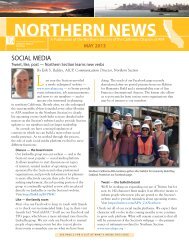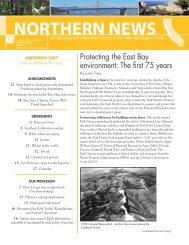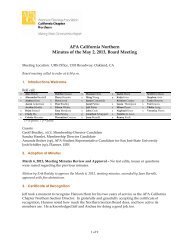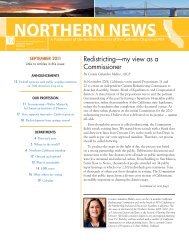Plan-it sustainably - Northern California Section
Plan-it sustainably - Northern California Section
Plan-it sustainably - Northern California Section
Create successful ePaper yourself
Turn your PDF publications into a flip-book with our unique Google optimized e-Paper software.
The display of calling cards from firmsoffering professional services appears inevery issue of <strong>Northern</strong> News. Fees paidby the firms for this service help defraythe costs of this newsletter.Lessons learned from LEED to lean (continued from page 1)The same logic holds true for reviewing policies that affectcommun<strong>it</strong>y planning projects. For example, we can promote wellnessby replacing older rules that foster trad<strong>it</strong>ional Euclidean Zoningpractices w<strong>it</strong>h mixed-use models that promote pedestrian modal<strong>it</strong>y asa form of connectiv<strong>it</strong>y. Studies show that walking trips to commercialareas are more frequent in neighborhoods w<strong>it</strong>h nearby stores andgrid-like street networks. 4 The evidence is becoming increasinglyclearer that urban form plays a role in the amount of physicalactiv<strong>it</strong>y in which we engage, and the link between reduced physicalactiv<strong>it</strong>y and chronic disease and cond<strong>it</strong>ions is largely undisputable 5 .Reviewing building plans to ensure that new and renovated buildingspromote healthy living can also be a means to removing barriersto promoting mobil<strong>it</strong>y and wellness. We can do simple things such asrequiring bicycle parking for employees and patrons; making stairsenjoyable, and giving them precedence over elevators or escalators;and s<strong>it</strong>ing outdoor spaces that promote modal<strong>it</strong>y and exploration overs<strong>it</strong>ting in meetings or at computers. In 2010, the American Inst<strong>it</strong>uteof Arch<strong>it</strong>ects partnered w<strong>it</strong>h the c<strong>it</strong>y of New York to create “ActiveDesign Guidelines” that promote healthy living in buildings, alongstreets, and in urban spaces. 6To promote healthy policies and remove the obstacles that keep usfrom implementing wellbeing in our planning practice, we can start bypartnering w<strong>it</strong>h experts who specialize in working w<strong>it</strong>h c<strong>it</strong>ies to targetharmful — and promote helpful — policies. Organizations such asChangeLab Solutions, Health Impact Partners, and GenerationsCommun<strong>it</strong>y Wellness are but a few that specialize in doing just that.We also can look to large granting organizations such as the PewFamily Trusts, The Robert Wood Johnson Foundation, and the<strong>California</strong> Endowment. They have allocated millions of dollars forcompet<strong>it</strong>ive grants to study the effects of this epidemic and inst<strong>it</strong>utecreative solutions.The problem is evident, the solutions are available, the experts arewa<strong>it</strong>ing, and the funding is plentiful. The only thing left to do is start.Peter Pirnejad is development services director for the C<strong>it</strong>y of Palo Alto.You can reach him at Peter.pirnejad@c<strong>it</strong>yofpaloalto.org4 Handy, SL, Understanding the link between urban form and nonwork travel behavior,Journal of <strong>Plan</strong>ning Education and Research, April 1996: vol. 15 no. 3:183-198.http://b<strong>it</strong>.ly/SWLDoX5 Ewing, Reid, Tom Schmid, Richard Killingsworth, Amy Zlot, and Stephen Raudenbush,“Relationship Between Urban Sprawl and Physical Activ<strong>it</strong>y, Obes<strong>it</strong>y, and Morbid<strong>it</strong>y,”American Journal of Health Promotion, 2003, Sept/Oct, Vol. 18, No. 1: 47-57.http://b<strong>it</strong>.ly/RM0xiF6 New York C<strong>it</strong>y Dept. of Design and Construction, http://on.nyc.gov/SWLIZR n“Too many people see compromise as a bad thing, an abandonment of principle. In real<strong>it</strong>y, a willingness tocompromise is a sign of great conviction: the conviction that the organization comes first. As easy as thatsounds, <strong>it</strong> is remarkably hard to adopt.” —John Baldoni, HBR Blog Network. http://b<strong>it</strong>.ly/TkuAOs<strong>Northern</strong> News 4 November 2012





![[NAME OF EVENT] EVALUATION FORM](https://img.yumpu.com/32351925/1/190x245/name-of-event-evaluation-form.jpg?quality=85)

